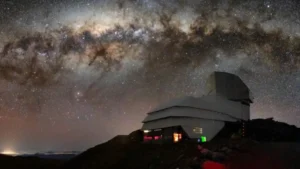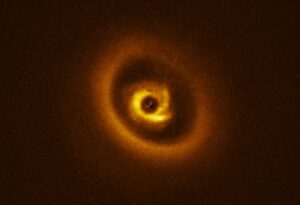The cosmic phenomenon known as “STEVE” made a surprise appearance on Sunday after a huge solar storm hit Earth.
Nope, this STEVE is not somebody’s brother or dad. The name is an acronym for Strong Thermal Emission Velocity Enhancement. Appearing as a giant ribbon of mauve light arcing across the night sky, it accompanied the vivid aurora visible in southern Canada and parts of the northern U.S.
Although it looks and behaves like an aurora, it is an unknown phenomenon. STEVE showed up as the northern lights faded. Alberta astronomer Alan Dyer tweeted:
“A great showing of @STEVEPhenomena last night, Aug 7-8, arcing across the sky, and showing his green fingers briefly for about 2 minutes,” Dyer said. “STEVE lasted about 40 minutes, appearing as the Kp5 aurora to the north subsided. This was 12:30 am MDT from southern Alberta.”
What is STEVE?
Canadian scientists first identified STEVE in 2016. Most of the time, the northern lights appear as ribbons swirling through the sky — often green or white. STEVE presents itself as pinkish-red or mauve and appears much further away from the Earth’s poles than most auroras.
Stranger still, the phenomenon sometimes includes vertical columns of green light nicknamed the “picket fence.”

The ‘picket fence’, seen as the faint vertical green streaks here. Photo: NASA Goddard Space Flight Center via Flickr
Initially, scientists believed that STEVE resulted from similar atmospheric disturbances as the aurora.
But then in 2019, researchers came up with a more detailed explanation of what sets STEVE apart. They concluded that the reddish arc and the green picket fence represented two distinct phenomena.
A mechanism similar to typical auroras likely produces the picket fence. In it, particles “precipitate” toward the earth from the magnetosphere. STEVE’s mauve streaks, on the other hand, appear because charged particles even higher up in the atmosphere heat up.
“Aurora is defined by particle precipitation, electrons and protons actually falling into our atmosphere, whereas the STEVE atmospheric glow comes from heating without particle precipitation,” said Bea Gallardo-Lacourt, a space physicist at the University of Calgary and co-author of the new study. “The precipitating electrons that cause the green picket fence are thus aurora, though this occurs outside the auroral zone, so it’s indeed unique.”





